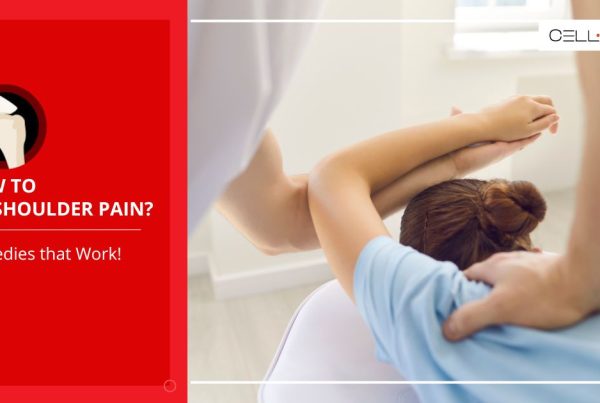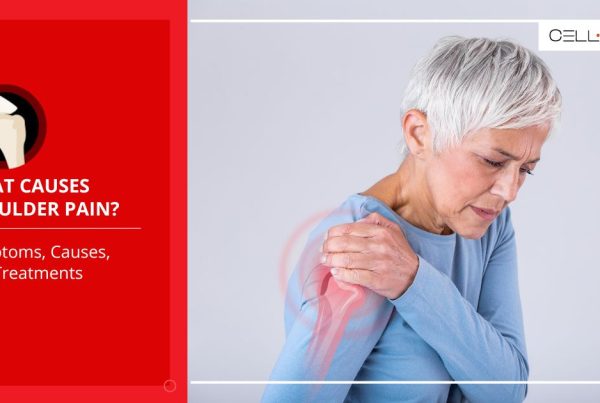Published on: September 27, 2019 | Updated on: August 29, 2024
The shoulder is a common source of pain for many individuals. Due to the repetitive nature of the tasks associated with shoulder movement, the soft tissues of the joints in the shoulder are especially susceptible to injury over time.
Of all the soft tissues within the shoulder, the labrum is the most commonly associated with pain. For Professional throwing athletes, surgery is typically the best option. However, for the rest of us, regenerative therapies may offer an alternative, less invasive treatment option.
The labrum is a special type of cartilage that cushions the ball-and-socket portion of the shoulder. The circular end of the humerus, a long bone in the upper arm, is held into the socket of the shoulder via a thin strand of tendon tissue that wraps from within the shoulder socket to the outside of the arm. Between the socket and the “ball” of the humerus, lies the labrum tissue which cushions, supports, and provides fluidity to the movements of the arm.
Hyperextension, “jamming,” untreated sprains, or acute injuries can cause a tear to form in the labrum. This can cause both acute and chronic pain deep within the shoulder with certain movements. Chronic injuries are common among throwing athletes and anyone who performs repetitive overhead motions. Labrum tears can occur when a person dislocates their shoulder or has a large force to the shoulder from a fall.
The following are the most prevalent signs of a labral tear:
- Overhead actions cause pain
- Popping, grinding, “sticking” in the shoulder socket
- The range of motion in the shoulder is limited
- Specific motion causes sharp pain, deep in the shoulder
- Loss of strength in the shoulder
Labral tears are best diagnosed by Orthopedic and Sports Medicine physicians. An evaluation for a tear may include common tests such as:
Obrien’s test/Speed’s test

The test is ideally done with the patient in a comfortable sitting position, although it may also be done standing up. The arm should be at 90 degrees of flexion and roughly 10 degrees of adduction when being assessed. The patient then inwardly rotates their arm, pronating at the elbow and pointing their thumb to the ground.
The examiner applies a downward force on the arm distally, while the patient resists by pushing up. The examiner can also advise the patient to externally rotate their arm at the same time while resisting it. After then, the test is repeated, but this time with the arm in neutral rotation.
If there is discomfort and/or clicking while the arm is in complete internal rotation but not in neutral rotation, the test is deemed positive. Discomfort above the acromioclavicular joint (a-c joint) implies a-c joint disease, but pain ‘deeper’ in the shoulder shows glenoid labrum pathology.
In the case of a-c joint pathology, the patient will most likely experience discomfort in both test postures.
Jerk test
The patient will bend their arm at the elbow, while the doctor places one hand on the elbow and the other at the base of the blade of the shoulder. The doctor will apply a quick shot of force to the elbow while palpating the shoulder blade. The doctor will evaluate for instability in the back portion of the labrum.
While these tests will give the doctor a relative idea of the location of the injury, imaging tests will help them define the scope of the injury. A popular diagnostic tool for labral tears is MR arthrogram. An MR arthrogram uses a special, injectable dye and MRI technology to give doctors an image of the soft tissues within the shoulder.
Once the images have been developed, a doctor will be able to properly diagnose one of several types of labral. There are a few varieties of labral tears. These include:
- SLAP tears: stands for “Superior Labrum Anterior Posterior” which means that the tear is in the upper part of the labrum and extends to the back and the front of the Labrum.
- Anterior and posterior tears: this means that the front part of the labrum is torn while a posterior tear means that the back portion of the labrum is torn.
- Bankart tears: located at the bottom of the labrum and usually occur after a person dislocates their shoulder.
Though the various types of labral tears induce pain in different portions of the shoulder, they are all treated similarly via conservative or surgical treatments. Conservative treatment includes:
- Anti-inflammatory medication
- Physical therapy
- Steroid injections
- Rest
If these conservative treatment options don’t reduce a patient’s pain, more invasive procedures are typically explored.
The purpose of labrum repair surgery is to reattach the torn tissue to the socket of the shoulder. This can be done with a standard incision on the front of the shoulder, or it can be done using a special technique known as arthroscopy.
Arthroscopic surgery entails a camera that is inserted by making an incision close to the injured joint. This makes it easier to understand the extent and the exact place of the injury. With that information, a surgeon can then re-attach or staple the labrum using the appropriate tools.
After surgery, a patient will be required to wear a sling until they regain their mobility, typically between 1-2 months. After that time physical therapy will be necessary to regain strength and movement. If the procedure was minor, the average patient is able to resume normal activities around 6-8 months after the surgery.
Surgery typically has positive results for all but Bankart tears. Patients with Bankart tears are much more likely to experience repeat dislocations of the shoulder post-surgery. Additionally, while most patients are able to return to daily activity after their surgeries, this does not account for the continued pain and instability these patients typically experience after such invasive procedures, especially over time.
Studies involving surgery patients well after their procedures prove that long-term results for shoulder surgery have shown mixed results. For example, a large review prospectively examined 225 patients with SLAP tears. After a follow-up at an average of 40.4 months, 179 patients completed the study.
Results looked at the range of motion of the shoulder. After shoulder surgery, the range of motion actually became far worse for many patients. Flexion and external rotation both decreased by 5 degrees and abduction decreased by 15 degrees on average. The summary is that while surgery may be able to re-attach the labrum, it isn’t statistically proven to restore the shoulder to its original health.
Conventional treatment options may not be the answer for everyone. The mainstay treatment is cortisone injections. The main issue with cortisone is that it has a short effective window, loses its potency with each injection, and is known to be degradative to joints.
Advancements in alternative treatment methods such as autologous stem cell therapy have led many to reconsider surgery for acute shoulder pain.
By harvesting stem cell-rich bone marrow or adipose (fat) tissues of an individual and reinjecting them into the site of injury, many of the patients at Cellaxys have experienced relief from their chronic shoulder pain.
Autologous tissues and stem cells have the added benefit of not only improving pain and function but potentially treating the underlying causes as well. These procedures can help restore unhealthy tissue while boosting the body’s natural healing processes.
If you have been seeking highly effective non-operative, minimally invasive procedures or if you’d like to boost the effects of physical therapy, or a previous surgery it may be time to consult one of the fellowship-trained medical experts at Cellaxys.
Sources
Footnotes
- Edwards SL, Lee JA, Bell JE, Packer JD, Ahmad CS, Levine WN, Bigliani LU, Blaine TA. Nonoperative treatment of superior labrum anterior posterior tears: improvements in pain, function, and quality of life. The American journal of sports medicine. 2010;38(7):1456-61.
- Provencher MT, McCormick F, Dewing C, McIntire S, Solomon D. A prospective analysis of 179 type 2 superior labrum anterior and posterior repairs: outcomes and factors associated with success and failure. The American Journal of Sports Medicine. 2013;41(4):880-6.
- Cruz-Ferreira E, Abadie P, Godenèche A, Mansat P, Clavert P, Flurin P, French Arthroscopy Society. Posterior shoulder instability: prospective non-randomised comparison of operative and non-operative treatment in 51 patients. Orthopaedics & Traumatology: Surgery & Research. 2017;103(8):S185-8.
- Christensen DL, Elsenbeck MJ, Wolfe JA, Nickel WN, Roach W, Waltz RA, Dickens JF, LeClere LE. Risk factors for failure of nonoperative treatment of posterior shoulder labral tears on magnetic resonance imaging. Military medicine. 2020;185(9-10):e1556-61.
- Shibata H, Gotoh M, Mitsui Y, Kai Y, Nakamura H, Kanazawa T, Okawa T, Higuchi F, Shirahama M, Shiba N. Risk factors for shoulder re-dislocation after arthroscopic Bankart repair. Journal of orthopaedic surgery and research. 2014;9(1):1-7.
- Banga K, Memon M, Baisi LP, Bedi A, Ayeni OR. Outcomes in surgical and conservative treatment of symptomatic non-traumatic shoulder labrum tears in the paediatric population: a systematic review. Journal of ISAKOS. 2017;2(3):140-6.
References
- What’s a Shoulder Labrum Tear Injury? MedicineNet. Accessed 2/23/2024.
- Shoulder Labrum Tear. Johns Hopkins Medicine. Accessed 2/23/2024.
- Labrum Tear Treatments. SPORTS-Health. Accessed 2/23/2024.
- Arthrogram (MRI). Radiopedia. Accessed 2/23/2024.
CELLAXYS does not offer Stem Cell Therapy as a cure for any medical condition. No statements or treatments presented by Cellaxys have been evaluated or approved by the Food and Drug Administration (FDA). This site contains no medical advice. All statements and opinions are provided for educational and informational purposes only.
Dr Pouya Mohajer
Author
Pouya Mohajer, M.D. is the Director of Spine and Interventional Medicine for CELLAXYS: Age, Regenerative, and Interventional Medicine Centers. He has over 20 years of experience in pain management, perioperative medicine, and anesthesiology. Dr. Mohajer founded and is the Medical Director of Southern Nevada Pain Specialists and PRIMMED Clinics. He has dedicated his career to surgical innovation and scientific advancement. More about the doctor on this page.
Dr Pejman Bady
Contributor
Dr. Pejman Bady began his career over 20 years ago in Family/Emergency Medicine, working in fast-paced emergency departments in Nevada and Kansas. He has served the people of Las Vegas as a physician for over two decades. Throughout this time, he has been met with much acclaim and is now the head of Emergency Medical Services in Nye County, Nevada. More about the doctor on this page.









